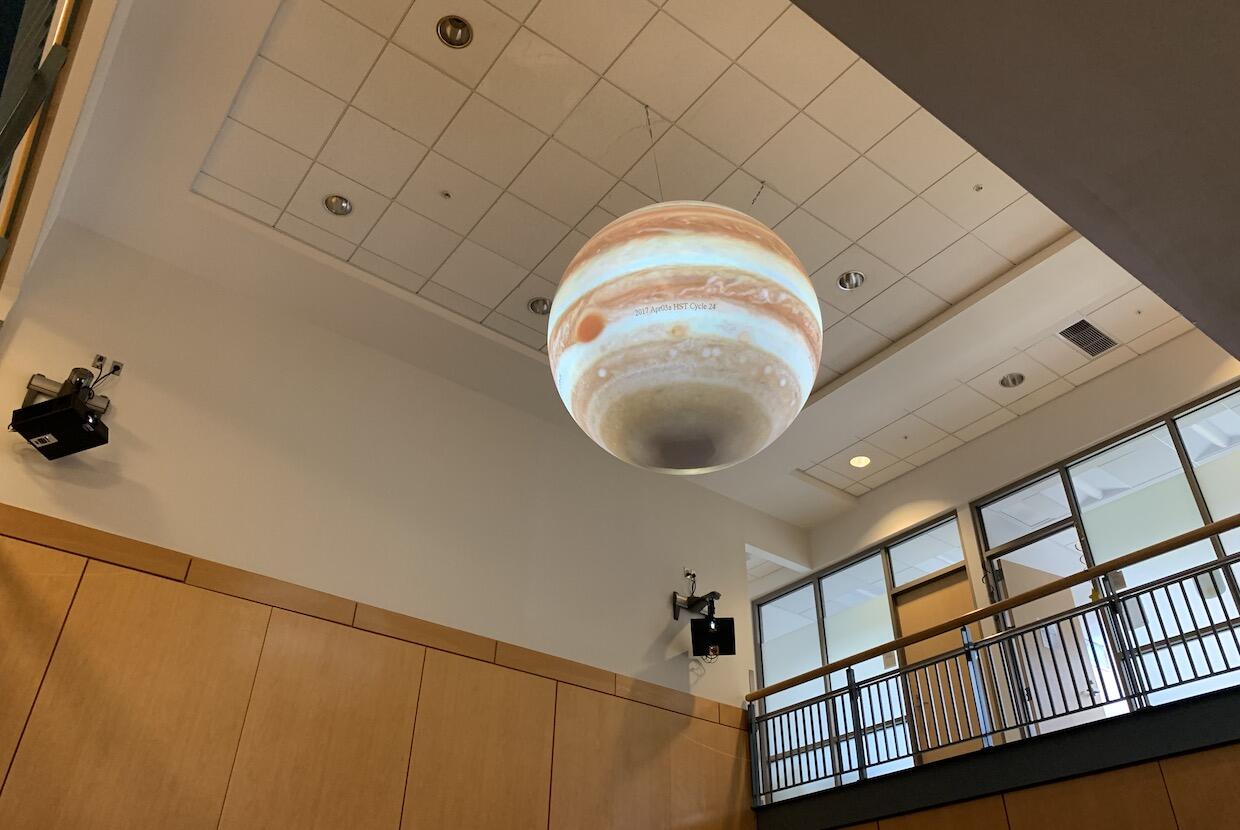
Sept. 2, 2020
Science On a Sphere, now at VCU, offers a world of possibilities
The global display system, on long-term loan from NASA, adds an element of awe to VCU’s Trani Center for Life Sciences.
Share this story
Anyone passing through the foyer of the Trani Center for Life Sciences at Virginia Commonwealth University will notice a fascinating new feature — a 6-foot diameter sphere suspended 25 feet above the ground. Known as Science On a Sphere, the global display system is on long-term loan from NASA’s Goddard Space Flight Center.
Science On a Sphere shows animated images of the atmosphere, oceans and land. It is primarily used as an education and outreach tool to describe the environmental processes of Earth. Four projectors illuminate the hollow, lightweight carbon-fiber sphere and give it life.
“The sphere doesn’t rotate, but it gives you the impression that it’s rotating,” said Robert Tombes, Ph.D., vice provost for life sciences and research. “It’s really amazing. It will capture your imagination.”

Alexander MacDonald, Ph.D., former director of the National Oceanic and Atmospheric Administration Earth System Research Laboratories in Boulder, Colorado, came up with the concept for the system in 1995, but it wasn’t patented to NOAA until 2005. It was originally developed by NOAA to explore environmental data using satellite views. NASA has purchased five systems from NOAA for education and public outreach to help the public understand the science of many of its missions.
The system displays NASA and NOAA scientific data and contains approximately 1,500 views of Earth, planetary systems and other animations. NASA Goddard was the fourth location in the world to install the system.
“We were at the leading edge of making the product work,” said Maurice Henderson, Science On a Sphere project manager at NASA Goddard. “We worked to make the system better and to make a rich library of observations from space that show Earth as well as other planets in our solar system.”
The NASA spheres are currently located at the Danville Science Center in Danville, Virginia; the Hubble Traveling Exhibit; Lewis Center for Educational Research in California; NASA’s Wallops Flight Facility on Virginia’s Eastern Shore; and at VCU.

Installing the system at VCU
The system has been in the Trani Center foyer since the first week of August. It took four days to install. “It wasn’t a trivial installation. It weighs about 50 pounds,” Henderson said. “We had to use a scissor lift to get it into place.”
The system will be an asset to classes in earth science and meteorology.
“This is suited to use in an instructional sense. The system will be running on a clock, but it can also be reserved for instruction. The School of Education is interested in using it to instruct science teachers and STEM instructors,” Tombes said.
Thomas Beatty, Ed.D., an assistant professor in the School of Education and director of the Child Development Center at VCU, referred Tombes to Henderson at NASA Goddard. Beatty sees Science On a Sphere as an opportunity for older children at the center to learn about science and the environment.
“We use interest-based curriculum at the center. We talk to the kids about planets and the Earth,” he said. “How cool would it be to take them somewhere on campus where they can see what we are talking about.”
Science On a Sphere represents a “whole different realm of learning,” Tombes said.
“There are a lot of videos that can be loaded into the system — anything that can be visualized in a spherical sense,” he said. “I think the possibilities are almost endless.”
Subscribe to VCU News
Subscribe to VCU News at newsletter.vcu.edu and receive a selection of stories, videos, photos, news clips and event listings in your inbox.










